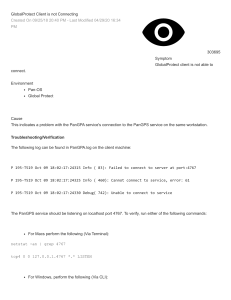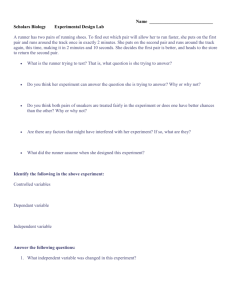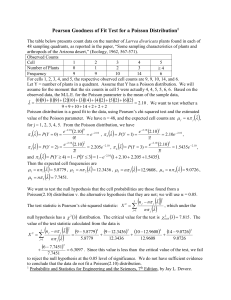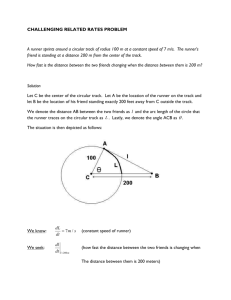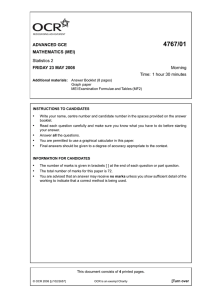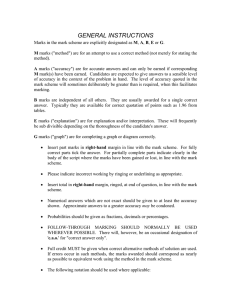4767 MATHEMATICS (MEI) ADVANCED GCE Friday 18 June 2010
advertisement
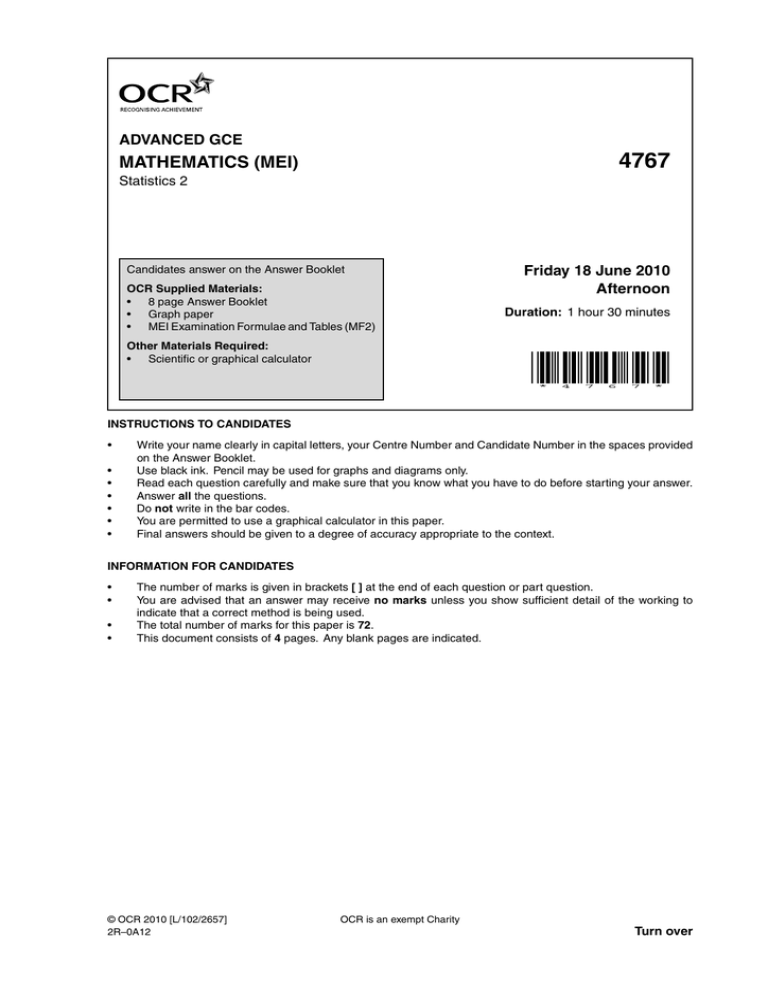
ADVANCED GCE 4767 MATHEMATICS (MEI) Statistics 2 Candidates answer on the Answer Booklet OCR Supplied Materials: • 8 page Answer Booklet • Graph paper • MEI Examination Formulae and Tables (MF2) Other Materials Required: • Scientific or graphical calculator Friday 18 June 2010 Afternoon Duration: 1 hour 30 minutes *4767* * 4 7 6 7 * INSTRUCTIONS TO CANDIDATES • • • • • • • Write your name clearly in capital letters, your Centre Number and Candidate Number in the spaces provided on the Answer Booklet. Use black ink. Pencil may be used for graphs and diagrams only. Read each question carefully and make sure that you know what you have to do before starting your answer. Answer all the questions. Do not write in the bar codes. You are permitted to use a graphical calculator in this paper. Final answers should be given to a degree of accuracy appropriate to the context. INFORMATION FOR CANDIDATES • • • • The number of marks is given in brackets [ ] at the end of each question or part question. You are advised that an answer may receive no marks unless you show sufficient detail of the working to indicate that a correct method is being used. The total number of marks for this paper is 72. This document consists of 4 pages. Any blank pages are indicated. © OCR 2010 [L/102/2657] 2R–0A12 OCR is an exempt Charity Turn over 2 1 Two celebrities judge a talent contest. Each celebrity gives a score out of 20 to each of a random sample of 8 contestants. The scores, x and y, given by the celebrities to each contestant are shown below. Contestant A B C D E F G H x 6 17 9 20 13 15 11 14 y 6 13 10 11 9 7 12 15 (i) Calculate the value of Spearman’s rank correlation coefficient. [5] (ii) Carry out a hypothesis test at the 5% significance level to determine whether there is positive association between the scores allocated by the two celebrities. [6] (iii) State the distributional assumption required for a test based on the product moment correlation coefficient. Sketch a scatter diagram of the scores above, and discuss whether it appears that the assumption is likely to be valid. [5] 2 A radioactive source is decaying at a mean rate of 3.4 counts per 5 seconds. (i) State conditions for a Poisson distribution to be a suitable model for the rate of decay of the source. [2] You may assume that a Poisson distribution with a mean rate of 3.4 counts per 5 seconds is a suitable model. (ii) State the variance of this Poisson distribution. [1] (iii) Find the probability of (A) exactly 3 counts in a 5-second period, (B) at least 3 counts in a 5-second period. (iv) Find the probability of exactly 40 counts in a period of 60 seconds. [5] [3] (v) Use a suitable approximating distribution to find the probability of at least 40 counts in a period of 60 seconds. [5] (vi) The background radiation rate also, independently, follows a Poisson distribution and produces a mean count of 1.4 per 5 seconds. Find the probability that the radiation source together with the background radiation give a total count of at least 8 in a 5-second period. [3] © OCR 2010 4767 Jun10 3 3 In a men’s cycling time trial, the times are modelled by the random variable X minutes which is Normally distributed with mean 63 and standard deviation 5.2. (i) Find (A) P(X < 65), (B) P(60 < X < 65). [6] (ii) Find the probability that 5 riders selected at random all record times between 60 and 65 minutes. [2] (iii) A competitor aims to be in the fastest 5% of entrants (i.e. those with the lowest times). Find the maximum time that he can take. [3] It is suggested that holding the time trial on a new course may result in lower times. To investigate this, a random sample of 15 competitors is selected. These 15 competitors do the time trial on the new course. The mean time taken by these riders is 61.7 minutes. You may assume that times are Normally distributed and the standard deviation is still 5.2 minutes. A hypothesis test is carried out to investigate whether times on the new course are lower. (iv) Write down suitable null and alternative hypotheses for the test. Carry out the test at the 5% significance level. [8] 4 In a survey a random sample of 63 runners is selected. The category of runner and the type of running are classified as follows. Category of runner Junior Senior Veteran Row totals Track 9 8 2 19 Road 4 8 12 24 Both 4 10 6 20 Column totals 17 26 20 63 Type of running (i) Carry out a test at the 5% significance level to examine whether there is any association between category of runner and the type of running. State carefully your null and alternative hypotheses. Your working should include a table showing the contributions of each cell to the test statistic. [12] (ii) For each category of runner, comment briefly on how the type of running compares with what would be expected if there were no association. [6] © OCR 2010 4767 Jun10 GCE Mathematics (MEI) Advanced GCE 4767 Statistics 2 Mark Scheme for June 2010 Oxford Cambridge and RSA Examinations 4767 Mark Scheme June 2010 Question 1 (i) x y Rank x Rank y d d2 6 6 8 8 0 0 17 13 2 2 0 0 9 10 7 5 2 4 20 11 1 4 -3 9 13 9 5 6 -1 1 15 7 3 7 -4 16 11 12 6 3 3 9 14 15 4 1 3 9 M1 for d2 A1 CAO for Σd2 Σd2 = 48 rs = 1 − M1 for attempt at ranking (allow all ranks reversed) 6Σd 2 6 × 48 = 1− 2 n(n − 1) 8 × 63 M1 for method for rs A1 f.t. for |rs| < 1 = 0.429 (to 3 s.f.) [ allow 0.43 to 2 s.f.] NB No ranking scores zero 5 (ii) H0: no association between X and Y in the population B1 for H0 H1: some positive association between X and Y in the population B1 for H1 B1 for population SOI 3 NB H0 H1 not ito ρ One tail test critical value at 5% level is 0.6429 B1 for ± 0.6429 Since 0.429 < 0.6429, there is insufficient evidence to reject H0, M1 for sensible comparison with c.v., provided that |rs| < 1 A1 for conclusion in context f.t. their rs and sensible cv i.e. conclude that there is not enough evidence to show positive association between the two judges’ scores. (iii) A bivariate Normal distribution is required. B1 Scatter diagram. G1 labelled axes G1 correct points E1 E1 TOTAL Suitable discussion 1 3 5 16 4767 Mark Scheme June 2010 Question 2 Counts have a uniform average rate of occurrence E1 All counts are independent E1 Variance = 3.4 B1 1 (A) M1 for use of tables or calculation A1 2 2 (i) (ii) Either P(X = 3) = 0.5584 – 0.3397 = 0.2187 (iii) 3.43 Or P(X = 3) = e−3.4 = 0.2186 3! (B) Using tables: P(X ≥ 3) = 1 – P(X ≤ 2) = 1 – 0.3397 M1 for 1 - P(X ≤ 2) M1 correct use of Poisson tables = 0.6603 A1 B1 for mean (iv) λ = 12 × 3.4 = 40.8 P(X = 40) = e−40.8 (v) M1 for calculation A1 40.840 = 0.0625 40! Mean no. per hour = 12 × 3.4 = 40.8 3 B1 for Normal approx. B1 for correct parameters (SOI) Using Normal approx. to the Poisson, X ~ N(40.8, 40.8) B1 for correct continuity corr. 39.5 − 40.8 P(X ≥ 40) = P Z > 40.8 = P(Z > – 0.2035) = Φ(0.2035) = 0.5806 M1 for probability using correct tail A1 CAO (3 s.f.) B1 for 4.8 Overall mean = 4.8 (vi) 3 P(X ≥ 8) = 1 – P(X ≤ 7) 5 M1 A1 = 1 – 0.8867 = 0.1133 TOTAL 2 3 19 4767 Mark Scheme June 2010 Question 3 (i) (A) P( X < 65) = 65 − 63 PZ < 5.2 = P( Z < 0.3846) = Φ(0.3846) = 0.6497 (B) M1 for standardizing M1 for structure A1 CAO (min 3 s.f.), 65 − 63 60 − 63 P(60< X < 65) = P <Z< 5.2 5.2 = P(–0.5769 < Z < 0.3846) = Φ(0.3846) – (1 – Φ(0.5769)) = 0.6497 – (1 – 0.7181) = 0.3678 NB When a candidate’s answers suggest that (s)he appears to have neglected to use the difference column of the Normal distribution tables penalise the first occurrence only M1 for standardizing both M1 for correct structure A1 CAO 3s.f. (ii) P(All 5 between 60 and 65) = 0.36785 = 0.00673 3 3 M1 A1 FT (min 2sf) 2 -1 (iii) From tables Φ ( 0.95 ) = 1.645 B1 for ±1.645 seen M1 for correct equation in k k − 63 = −1.645 5.2 x = 63 – 5.2 × 1.645 = 54.45 mins (iv) H0: μ = 63 minutes; H1: μ < 63 minutes. Where μ denotes the population mean time on the new course. Test statistic = 61.7 − 63 5.2 / 15 = –0.968 = −1.3 1.3426 A1 CAO 3 B1 for use of 63 B1 for both correct B1 for definition of μ 3 M1 must include √15 A1 5% level 1 tailed critical value of z = 1.645 –0.968 > –1.645 so not significant. There is not sufficient evidence to reject H0 B1 for ±1.645 M1 for sensible comparison leading to a conclusion There is insufficient evidence to conclude that the new course results in lower times. 3 A1 FT for correct conclusion in words in context 5 19 4767 Mark Scheme June 2010 Question 4 (i) H0: no association between category of runner and type of B1 running; H1: some association between category of runner and type of running; Track Road Both Junior 5.13 6.48 5.40 Senior 7.84 9.90 8.25 Veteran 6.03 7.62 6.35 CONTRIBUTN Junior Senior Veteran EXPECTED Track Road Both 2.9257 0.9468 0.3615 0.0032 0.3663 0.3694 2.6949 2.5190 0.0192 M1 A2 for expected values (to 2 dp) (allow A1 for at least one row or column correct) M1 for valid attempt at (O-E)2/E A1 for all correct NB These M1A1 marks cannot be implied by a correct final value of X 2 X = 10.21 M1 for summation A1 for X2 Refer to X 42 B1 for 4 deg of f 2 1 7 B1 CAO for cv Critical value at 5% level = 9.488 B1 FT their ‘sensible’ X2 Result is significant There is evidence to suggest that there is some E1 must be consistent association between category of runner and type of running. with their X2 4 NB if H0 H1 reversed, or ‘correlation’ mentioned, do not award first B1or final E1 (ii) • Juniors appear be track runners more often than expected and road less often than expected. E1 E1 • Seniors tend to be as expected ín all three categories of running. E1 E1 • Veterans tend to be road runners more than expected and track runners less than expected. E1 E1 TOTAL 4 6 18
